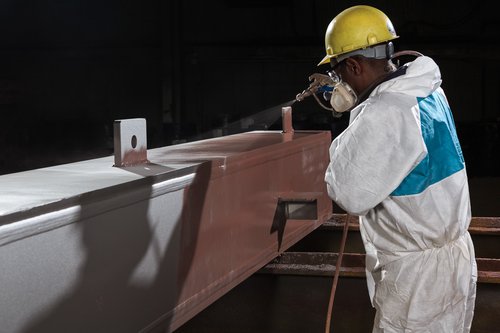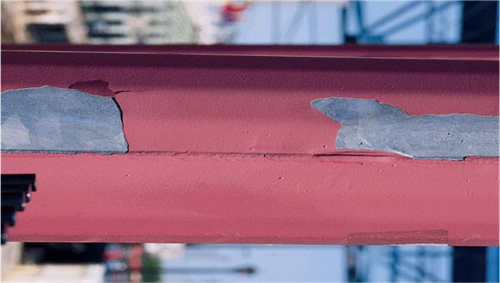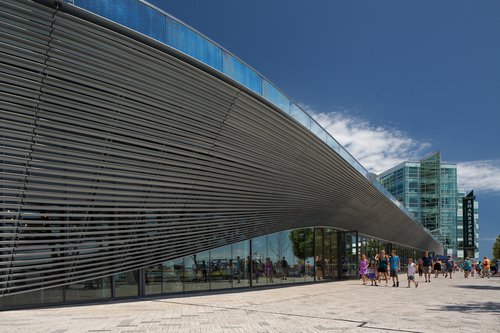Can I Coat Galvanized Steel?
This is a very common question. And it is often done. But you'll need to know all the necessary steps for coating galvanized metal surfaces. This article can help.
Planning on galvanizing AND a coating system?
If you plan to coat steel, a zinc-rich primer is a better option than galvanizing. The best possible corrosion protection on steel is to have it coated with zinc followed by a high-performance coating system. Both galvanizing metal and shop-applying zinc-rich primers are processes that provide excellent corrosion protection for steel. But, while applying coatings to primed steel is a relatively easy process, applying high-performance coatings to galvanized steel can be a very difficult process.
If it's too late to consider a zinc-rich primer, then here are a few guidelines you'll need to consider…

Determine the Age of the Galvanized Steel
Knowing the age of the galvanized steel prior to painting is important because age determines what type of surface preparation is required. Zinc oxide and hydroxide hinder the paint’s ability to adhere to unaged galvanizing. However, over the course of six to 24 months the zinc surface weathers and forms a thin, dense film of mostly zinc carbonate, called the zinc patina. Once the patina has fully formed, the particulates no longer interfere with paint adhesion.
Galvanized coatings can generally be grouped into three categories: newly galvanized, partially weathered, and fully weathered. The length of time a galvanized coating takes to reach each age level depends on environmental conditions, such as humidity, temperature, wind, etc.
INSPECT THE GALVANIZED STEEL
Determine if the galvanized steel requires chromate testing. Sometimes galvanized steel is dipped in a chromate bath immediately after galvanizing. The chromates can greatly interfere with paint adhesion and must be removed prior to painting. This testing is fairly simple and is described in ASTM B 201.
Regardless of the age of the galvanized coating, it should not have surface imperfections (significant bumps, sharp icicles, high spots, or extremely rough edges). This is important because protrusions greater than the paint’s dry film thickness (5-10 mils) interfere with adhesion and can cause voids in the paint coating. To smooth out surface blemishes, hand-file or power-sand the area. Be very careful not to remove any more of the protective zinc coating than necessary.
CLEAN THE GALVANIZING
Cleaning recommendations are based on the type of galvanizing. The types are broken into newly galvanized, partially weathered galvanized and fully weathered galvanized.
- Newly Galvanized Steel: no dirt or grease present with few zinc oxides and hydroxides formed; no major cleaning necessary.
- Partially Weathered Galvanized Steel: must remove surface oxide and hydroxide film, as well as dirt and grime.
- Fully Weathered Galvanized Steel: requires minimal cleaning, such as a warm-water power wash to remove contaminants from the surface. Power wash should not exceed 1450 psi.
NOTE: The goal of surface cleaning is to remove the grease, dirt and oils from the galvanized surface in order to promote paint adhesion. If it is determined the galvanized surface needs to be cleaned, any of the methods listed below can be used. Remember, a cleaning solution is meant to clean the zinc surface, not remove it. Some cleaners may react poorly with certain paint systems. Be sure to consult the paint manufacturer regarding specific cleaning instructions.

SURFACE PROFILING IS PARAMOUNT
Galvanized surfaces need to be sweep blasted, but can be easily over blasted. Follow the below guidelines when surface profiling galvanized steel.
Sweep Blasting: The most common way of profiling galvanized steel. Particle size for a sweep blast of galvanized steel should range between 200 and 500 microns (8-20 mils). Consult SSPC SP 7 for sweep blasting procedures.
Overblasting: When the galvanized coating is overblasted, too much zinc is removed. Because the zinc protects the steel from corrosion as the paint wears away, the steel will rust if the zinc isn’t there to protect it. If this is the case, then the system will fail. To avoid this problem, be sure to use the correct media for sweep blasting galvanized surfaces, and do not blast in one area for too long.
USE A PRIMER WITH PREPARED GALVANIZED STEEL
After cleaning and profiling the galvanized surface, a prime coat should be used to help with paint adhesion. Many types of paints react poorly when applied directly on prepared galvanized surface, but primers allow for the successful use of many of these paint types. Priming of galvanized surfaces should be done as soon as possible after cleaning and profiling. The zinc in the galvanized steel continually reacts with the environment, and zinc oxides and hydroxides begin to build up right away, which can cause paints not to bond to the substrate. Always apply primers according to the manufacturer’s directions and the specified paint system.

APPLYING THE COATING SYSTEM TO THE GALVANIZED STEEL
Always consult the paint/coatings manufacturer prior to painting galvanized steel. The manufacturer can provide more thorough information about the compatibility of specific systems with galvanized steel. Different physical and chemical characteristics for the same types of paint may have varied reactions with a galvanized surface, especially coating thickness.
Conclusion
Unfortunately, coating projects over hot dipped galvanizing can be challenging. When you compare all the procedures, inspection, testing, cleaning, profiling, etc., with the application of a shop-applied zinc-rich primer, the choice becomes clear. Unless the galvanized metal is not going to be coated, the better choice is to use a zinc-rich primer.
In addition, the welds of galvanized steel (which are the most prone to corrosion) are normally touched-up with zinc. And think of it this way: if the critical areas of galvanized touch-up work is done using zinc-rich coatings, doesn’t it make sense to prime with zinc-rich, too?
For more information about coating galvanized surfaces, download this technical bulletin or contact your local Tnemec representative.
E-News
Coating News Direct to Your Inbox
Stay informed about industry news and innovative coating products via email.
Contact Your Rep
Looking for Some Local Coatings Guidance?
Reach out to one of our knowledgable and reliable representatives near you.
TnemecU
Want to Earn Some CEUs?
Check out all of Tnemec's coating courses, available on demand and in person.